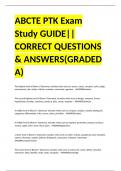ABCTE PTK Exam
Study GUIDE||
CORRECT QUESTIONS
& ANSWERS(GRADED
A)
The highest level in Bloom's Taxonomy. Includes verbs such as: assess, create, compare, solve, judge,
recommend, rate, relate, criticize, evaluate, summarize, appraise. - ANSWEREvaluate
The second highest level in Bloom's Taxonomy. Includes verbs such as design, compose, invent,
hypothesize, develop, construct, produce, plan, create, organize. - ANSWERSynthesis
A middle level in Bloom's Taxonomy. Includes verbs such as compare, analyze, classify, distinguish,
categorize, differentiate, infer, survey, select, prioritize. - ANSWERAnalysis
A middle level in Bloom's Taxonomy. Includes verbs such as organize, generalize, prepare, produce,
choose, apply, solve, draw, show, paint. - ANSWERApplication
a lower level in Bloom's Taxonomy. Includes verbs such as match, restate, paraphrase, give examples,
express, illustrate, explain, defend, distinguish, summarize, interpret, interrelate. -
ANSWERcomprehension
The lowest level in Bloom's Taxonomy. Includes verbs such as select, list, name, define, describe,
memorize, label, identify, recite, state, recognize. - ANSWERknowledge
,Curricular standards communicate what? - ANSWERwhat, when, and how to teach
what lesson plans are designed to meet or achieve - ANSWERstandards
the most important educational document - ANSWERthe lesson plan
what does curriculum contain? - ANSWERobjectives, sample lessons, assessments, procedures,
materials/equipment needed, activities, samples of student work
what the student is supposed to learn - ANSWERobjective
methods of determining effectiveness of the lessons - ANSWERassessments
What was the purpose of No Child Left Behind and the Every Student Succeeds Act? - ANSWERto
create a standardized curriculum for each subject area
should you schedule assessments based on the calendar date or the progress of the class? -
ANSWERbased on progress of the class
Who do you need to know before you begin planning lessons? - ANSWERyour students
who can help you get to know your students? - ANSWERprior teachers, counselors, administrators,
other colleagues
How much repetition is enough? - ANSWERas much as possible until mastery is acheived
What should inform your instruction? - ANSWERassessments
Name three important things to consider when choosing a seating arrangement. - ANSWER1.
visibility of students
2. movement by the teacher
3. space for isolation
,4. students should always be in front of the teacher
5. utilize a second teacher's desk in the room
6. considers the distance between students
what is fostered when students are seated close together or in groups? - ANSWERinteraction
between students
when should you prepare class rules and their consequences? - ANSWERBEFORE school begins
Name some ways to create a positive learning environment. - ANSWER1. greet students at the door
2. display examples of student work
3. make the classroom feel open, welcoming, and caring
Definition= The learning and practice of teaching - ANSWERPedagogy
Lessons are intended for the _________________ of the audience, not for the
____________________ of the teacher. - ANSWERbenefit
convenience
What are the steps of the Learning Cycle based on Piaget's learning theory? - ANSWER1. exploration
2. concept introduction
3. concept application
In Piaget's learning cycle, exploration is what? - ANSWERthe beginning of instruction
addresses the concrete level of thinking- lower order thinking skills
teacher's job is to replace misconceptions with correct knowledge
When beginning a lesson, you should provide... - ANSWERa context for the material
, In Piaget's learning cycle, concept introduction is... - ANSWERthe teaching stage
the guided discovery stage- students are constructing meaning based on the teacher's lessons
In Piaget's learning cycle, concept application is... - ANSWERwhere students apply what they have
learned to new situations
students formulate a new idea or understanding
should lead directly into the exploration stage of the next curricular concept
what are some ways to identify what the students already know? - ANSWER1. offer a pre-test on the
material
2. group discussion
3. student interviews
4. classroom participation
how can you provide context for learning new concepts? - ANSWERcreate "bridges" between the old
and the new
what are some ways to stimulate active learning? - ANSWER1. minimize unnecessary info or
distractions
2. utilize sufficient relevant examples
3. organize curriculum around a central theme or idea
4. require review, memorization, repetition, and mnemonic devices
5. provide study and memory aides prior to the lesson
warm-up, lecture, demonstrations, gallery walk, using graphic organizers, and questioning are all
teaching strategies to use with what types of groups? - ANSWERwhole/large groups
what is a "bell ringer"? - ANSWERdaily work that is completed by the students as soon as they enter
the room




